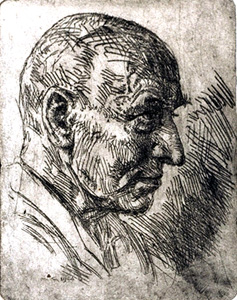The directory «Artists»
Dunikowski Xawery
(1875—1964)

Xawery Dunikowski studied at the Kraków Academy of Fine Arts and became Professor of Sculpture at the Warsaw Academy of Fine Arts in 1902. 1909 he was appointed to the Chair for Sculpture at the Kraków Academy of Fine Arts. His pre-World War II oeuvre included two major sculpture cycles: Heads from the Kraków Palace and Pregnant Women. May 15, 1940, Dunikowski was arrested in Kraków by the Gestapo and on June 26, deported to Auschwitz, where he was assigned prisoner number 774.He was assigned to various labor details, then to the Auschwitz Camp Museum, and finally to the construction office, where he was ordered to build a model of the camp. Despite several requests by SS guards, Dunikowski refused to produce any sculpture at Auschwitz. He later said: «I died there, and couldn't do anything at all». In 1942, Dunikowski fell ill with typhus and was sent to the prisoner infirmary. He was selected to be gassed but was saved by a Polish physician, who crossed his name off the list of infirmary patients. September 1943, Dunikowksi was accused of belonging to the camp resistance movement, thrown into a cell in barrack (Block) 11 and sentenced to be shot, but his sentence was commuted. Dunikowski returned to the camp hospital, where in 1944, during a long recovery process, he began to make sketches and portraits of his fellow prisoners. A large number of these drawings were smuggled out of Auschwitz by other prisoners, one of whom, Wacław Weszke, worked in a labor crew outside the camp and smuggled drawings out by wrapping them around his legs under his trousers. The drawings were later sent to Kraków. Dunikowski was still hospitalized when the SS evacuated Auschwitz in January 1945. He was liberated by the Red Army that month, on January 27, 1945. Dunikowski resumed his professorship at the Kraków Academy of Fine Arts in 1946 and saw major exhibitions of his work held in Kraków in 1948, Warsaw in 1949 and 1958, Moscow in 1949 and 1958, and Venice in 1954. 1955 Dunikowski moved to Warsaw, where he created the second version of his pre-World War II cycle Heads from the Kraków Palace. Throughout Dunikowski's postwar career, he completed many sculptures, monuments, drawings, and other works about his experiences at Auschwitz.
Poland, 1955, Mask of Adam Mickiewicz